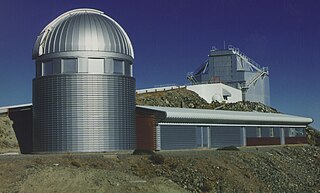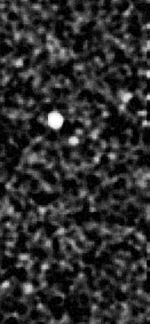Related Research Articles
Mu Arae c, also known as HD 160691 c, formally named Dulcinea, is an extrasolar planet orbiting the star Mu Arae of the constellation Ara. It was the first 'hot Neptune' to be discovered.
HD 100777 is a single star with a planetary companion in the equatorial constellation of Leo. With an apparent visual magnitude of 8.42 it is too faint to be viewed with the naked eye, although the absolute magnitude of 4.81 indicates it could be seen if it were just 33 ly (10 pc) away. The distance to the star is approximately 162 light years based on parallax measurements.
HD 190647 is a yellow-hued star with an exoplanetary companion, located in the southern constellation of Sagittarius. It has an apparent visual magnitude of 7.78, making this an 8th magnitude star that is much too faint to be readily visible to the naked eye. The star is located at a distance of 178 light years from the Sun based on parallax measurements, but is drifting closer with a radial velocity of −40 km/s. It is also called HIP 99115.
HD 221287, named Poerava, is a star in the southern constellation of Tucana. It has a yellow-white hue but is too faint to be viewed with the naked eye, having an apparent visual magnitude of 7.82. This object is located at a distance of 183 light years from the Sun, as determined from its parallax. It is drifting closer with a radial velocity of −22 km/s.
HD 190647 b is >1.9 MJ planet orbiting the star HD 190647 at 309.7 gigameters or 10.04 μpc away from the star, taking 89.69 megaseconds to orbit the star with average velocity of 21.8 km/s. The orbital eccentricity is 18%. Dominique Naef discovered this planet in early 2007 by using HARPS spectrograph located in Chile.
HD 221287 b, also known as Pipitea, is an exoplanet that orbits HD 221287, approximately 173 light years away in the constellation of Tucana. This planet has mass >3.12 MJ and orbits in a habitable zone at 1.25 AUs from the star, taking 1.25 years to orbit at 29.9 km/s around the star. Dominique Naef discovered this planet in early 2007 by using HARPS spectrograph located in Chile.
HD 153950 b, also known as Trimobe, is an extrasolar planet located approximately 162 light-years away. This planet was discovered on October 26, 2008 by Moutou et al. using the HARPS spectrograph on ESO's 3.6 meter telescope installed at La Silla Observatory in Atacama desert, Chile.

Leonhard Euler Telescope, or the Swiss EULER Telescope, is a national, fully automatic 1.2-metre (47 in) reflecting telescope, built and operated by the Geneva Observatory. It is located at an altitude of 2,375 m (7,792 ft) at ESO's La Silla Observatory site in the Chilean Norte Chico region, about 460 kilometers north of Santiago de Chile. The telescope, which saw its first light on 12 April 1998, is named after Swiss mathematician Leonhard Paul Euler.
HD 8535 b is an extrasolar planet which orbits the G-type main sequence star HD 8535, located approximately 171 light years away in the constellation Phoenix. This planet has at least five-eighths the mass of Jupiter and takes 3.6 years to orbit the star at a semimajor axis of 2.47 AU. However unlike most other known exoplanets, its eccentricity is not known, but it is typical that its inclination is not known. This planet was detected by HARPS on October 19, 2009, together with 29 other planets.
HD 28254 is a binary star system located 180 light-years away in the constellation Dorado. The primary component is an 8th magnitude G-type main-sequence star. This star is larger, cooler, brighter, and more massive than the Sun, and its metal content is 2.3 times as much as the Sun. In 2009, a gas giant exoplanet was found in orbit around the star.
HD 28254 b is an exoplanet which orbits the G-type main sequence star HD 28254, located 180 light-years away in the constellation Dorado.
HD 290327 b is an extrasolar planet which orbits the G-type subgiant star HD 290327, located approximately 180 light years away in the constellation Orion. This planet has at least five halves the mass of Jupiter and takes 6.7 years to orbit the star at a semimajor axis of 3.35 AU. However unlike most other known exoplanets, its eccentricity is not known, but it is typical that its inclination is not known. This planet was detected by HARPS on October 19, 2009, together with 29 other planets.
HD 44219 b is an extrasolar planet which orbits the G-type main sequence star HD 44219, located approximately 164 light years away in the constellation Monoceros. This planet has at least three-fifths the mass of Jupiter and takes 1.29 years to orbit the star at a semimajor axis of 1.18 AU. However unlike most other known exoplanets, its eccentricity is not known, but it is typical that its inclination is not known. This planet was detected by HARPS on October 19, 2009, together with 29 other planets.
HD 148156 is a star with an orbiting exoplanet in the southern constellation of Norma. It is located at a distance of 186 light years away from the Sun, but is drifting closer with a radial velocity of –1.8 km/s. The star has an apparent visual magnitude of 7.69, which is too dim to be visible to the naked eye. A survey in 2015 ruled out the existence of any stellar companions at projected distances from 49 to 345 astronomical units.
HD 148156 b is an extrasolar planet which orbits the G-type main sequence star HD 148156, located approximately 168 light years away in the constellation Norma. This planet has at least nine-tenths the mass of Jupiter and takes 25 ninths years to orbit the star at a semimajor axis of 2.06 AU. However unlike most other known exoplanets, its eccentricity is not known, but it is typical that its inclination is not known. This planet was detected by HARPS on October 19, 2009, together with 29 other planets.
HD 156411 b is an extrasolar planet which orbits the G-type main sequence star HD 156411, located approximately 179 light years away in the constellation Ara. This planet has at least three-fourths the mass of Jupiter and takes eight-thirds years to orbit the star at a semimajor axis of 1.81 AU. However unlike most other known exoplanets, its eccentricity is not known, but it is typical that its inclination is not known. This planet was detected by HARPS on October 19, 2009, together with 29 other planets.

An exoplanet is a planet located outside the Solar System. The first evidence of an exoplanet was noted as early as 1917, but was not recognized as such until 2016; no planet discovery has yet come from that evidence. What turned out to be the first detection of an exoplanet was published among a list of possible candidates in 1988, though not confirmed until 2003. The first confirmed detection came in 1992, with the discovery of terrestrial-mass planets orbiting the pulsar PSR B1257+12. The first confirmation of an exoplanet orbiting a main-sequence star was made in 1995, when a giant planet was found in a four-day orbit around the nearby star 51 Pegasi. Some exoplanets have been imaged directly by telescopes, but the vast majority have been detected through indirect methods, such as the transit method and the radial-velocity method. As of 1 March 2024, there are 5,640 confirmed exoplanets in 4,155 planetary systems, with 895 systems having more than one planet. This is a list of the most notable discoveries.

HD 219134 b is one of at least five exoplanets orbiting HD 219134, a main-sequence star in the constellation of Cassiopeia. HD 219134 b has a size of about 1.6 R🜨, and a density of 6.4 g/cm3 and orbits at 21.25 light-years away. The exoplanet was initially detected by the instrument HARPS-N of the Italian Telescopio Nazionale Galileo via the radial velocity method and subsequently observed by the Spitzer telescope as transiting in front of its star. The exoplanet has a mass of about 4.5 times that of Earth and orbits its host star every three days. In 2017, it was found that the planet likely hosts an atmosphere.

HD 89345 b is a Neptune-like exoplanet that orbits a G-type star. It is also called K2-234b. Its mass is 35.7 Earths, it takes 11.8 days to complete one orbit of its star, and is 0.105 AU from its star. It was discovered by 43 astrophysicists, one which is V. Van Eylen, and is announced in 2018.
HD 1690 is a giant star with an orbiting exoplanet companion in the constellation of Cetus. It has an apparent visual magnitude of 9.19, which is too faint to be visible to the naked eye. The distance to this system is approximately 2,570 light years, and it is drifting further away with a radial velocity of +18.2 km/s. HD 1690 has no known companion star, making it a single star system.
References
- 1 2 Naef, D.; et al. (2007). "The HARPS search for southern extra-solar planets IX. Exoplanets orbiting HD 100777, HD 190647, and HD 221287". Astronomy and Astrophysics. 470 (2): 721–726. arXiv: 0704.0917 . Bibcode:2007A&A...470..721N. doi:10.1051/0004-6361:20077361. S2CID 119585936.
- ↑ "Approved names". NameExoWorlds . Retrieved 2020-01-02.